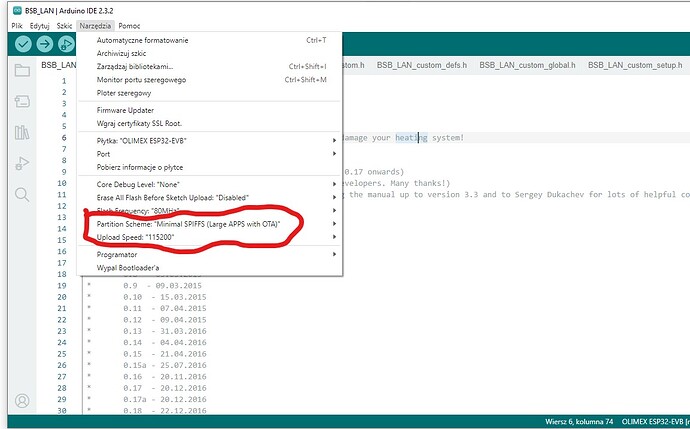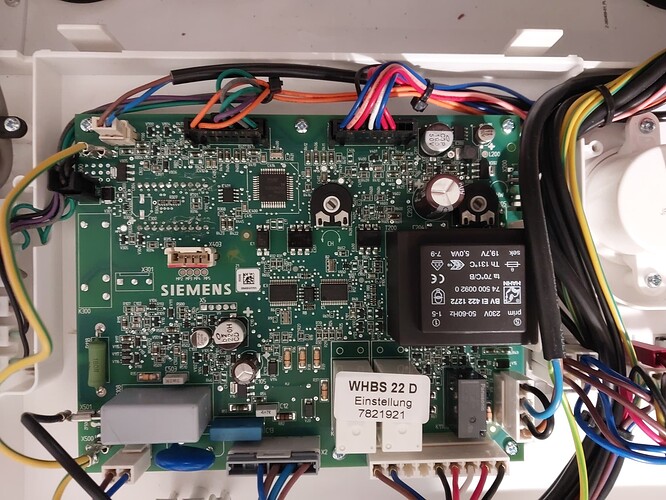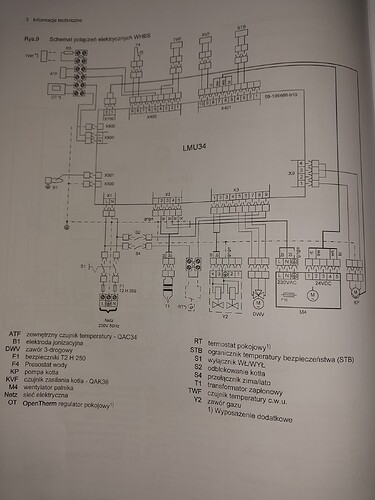Witam!
Czy ktoś ma albo wie jak zrobić integrację z kotłem gazowym brotje WHBS regulator pokojowy to IDA
Może tam coś znajdziesz. https://community.home-assistant.io/t/bsb-lan-integration/113501
Tylko problem w tym, że nie wiem gdzie i jaki moduł kupić. No i jak go zprogramować
Contact Fred to order one:
If you have an IDA, basically you just need to use the same two wires which goes into the IDA. All the communication is really MBUS. So they can work on the same wires, side-by-side, if I am not mistaken, but Fred can answer that as well.
Tylko gdzie to można kupić
Interface kits available!
Interface boards are available for the ESP32 upon request. These can simply be plugged on top of one of the listed microcontrollers.Getting the board from here helps supporting this project in the future, so if you are interested, please send Frederik an e-mail (German or English) to
bsb (ät) code-it.de
for further informations.
You will receive an answer like this:
First of all, you have to choose the platform that you want to run the BSB-LAN adapter on:
- Arduino Due: The original platform for this project, established for years, many add-on „shields“ available, but WiFi is a bit tricky, so its best for LAN usage.
- ESP32 NodeMCU (30 pins): Recently added to the project, limited extensions possible, but small, cheap and has WiFi on board.
- ESP32 Olimex EVB: An all-round mulit-purpose board with LAN, WLAN, Micro-SD card adapter and two switchable relays. Costs are about the same as an Arduino Due with Ethernet Shield.
I myself have used the Arduino Due for years but have recently switched to the Olimex EVB because of its compact footprint.
Once you have decided which platform you want to use, you can choose the BSB-LAN adapter in one of these models:
- 20 Euros for plain PCB
- 25 Euros for PCB plus parts
- 40 Euros for a soldered board
These are 2021 prices, I don’t know how they are nowadays.
Czyli jeżeli kupię tą płytkę to bez problemu podłączę do niej IDĘ?
Nie, nie podłączysz…
ta płytka MCU (ESP32 z Ethernetem) jest tylko jednym z elementów bramki DIY umożliwiającej podłączenie magistrali BSB (z logiką 12V, chyba BSB to jakaś wariacja na bazie OpenTherm? ale nie wczuwałem się w temat) z automatyką domową.
PS no chyba że stosujesz jakieś ultra-skróty myślowe i piszesz jedno zdanie, a na myśli masz całą książkę…
Czyli co muszę kupić aby (nie znam angielskiego, jestem z pokolenia gdzie uczono język wroga - rosyjski) podłączyć IDĘ pod HA przez BSB-LAN?
Ja też i żyję… (po angielsku mówię chyba gorzej niż hindusi) przejrzałem za Ciebie dokumentację, stąd pewne wnioski, ale zrozum, że ilość czasu którą mogę poświecić na taką zabawę dla innych jest ograniczona
Czy sterownik IDA podłączysz? - tego nie wiem (nie ma go nigdzie na liście wspieranego sprzętu, i są tam tylko sterowniki pieców, a nie termostaty, ale zakładam, że jakaś szansa na sukces jest, bo to musi być coś podobnego do OpenTerm).
Natomiast aby zbudować bramkę BSB ← → LAN (czyli w efekcie i HA) potrzebujesz
-
płytkę interfejsu BSB-LAN i w tej sprawie musisz skrobnąć maila po niemiecku lub angielsku do @fredlcore, adres maila jest w dokumentacji
-
jakąś wspieraną płytkę MCU (ta którą wspomniałeś może być, ale nie wiem jak bardzo jesteś zaawansowany w budowaniu elektroniki, więc popytaj w tym mailu co gość ma do sprzedania, może też ma gotowe bramki)
-
wsad do MCU, który sobie sam skompilujesz
Chociaż próbowałeś czytać i zrozumieć te instrukcje?
dla płytek ESP32 (znajdziesz tam też instrukcję w pdf, która ma 230 stron, więc miej litość, musisz to ogarniać choć trochę bardziej samodzielnie)
i ewentualnie dla Arduino Due (opcjonalnie, nie umiem ocenić czy ona Ci pomoże czy zaszkodzi, bo dotyczy innego MCU)
I jeszcze jedno, ale ważne (zakładałem wstępnie, że jesteś pewien co do tego, że ten projekt jest zgodny ze sterownikiem pieca i tego nawet nie sprawdzałem! bo systematycznie brniesz w ten temat) - ja na liście przetestowanego sprzętu Broetje nie widzę nic, co by mogłoby się nazywać WHBS
za to jest notatka o modelach niewspieranych (tak o tym pomyślałem, bo ten termostat IDA wygląda wybitnie nowocześnie i wcale nie ma pewności czy kontroler pieca nie jest też zbyt nowoczesny)
The new models WLS/WLC and BOK by Broetje are NOT compatible with BSB-LAN!
I am really sorry, but I do not speak Polish, but I have a magic tool built into my browser! Right click, and “Translate to”…
@szopen summed it up very well. The communication is a form of mBUS, as I remember, but specific for these heater controllers. Basically your IDA communicates the same way with the heater as the BSB-LAN device, but as far as I know the IDA cannot communicate with HA itself.
You should be able to connect the BSB-LAN device to your heater with the same cable as the IDA, I believe, because mBUS can happen with multiple devices on the same pair of cables, because it uses addresses for each device.
The documentation is really detailed on how the device is working. With the aforementioned trick, you can translate it to Polish and the result should be fully understandable.
Też myślę że to zadziała (mam taką nadzieję) jak przyjdą sprzęty to podłączę i zobaczymy.
edit.
Proszę o pomoc w zaprogramowaniu ESP32 Olimex EVB.
problem jest w tym że jak wgram BSB-LAN do płytki to kasuje mi się połączenie wifi i odwrotnie jak wgram wifi to nadpisuje się BSB-LAN.
jak to że tak powiem scalić aby instalacja jednego nie usuwała drugiego?
Musisz opisać bardziej szczegółowo co konkretnie robisz, bo obawiam się że ten opis jest niemożliwy do zrozumienia…
Najlepiej opisuj krok po kroku, z przeklejkami kodu (tylko istotnych fragmentów) i screenshotami.
Tak w nawiązaniu do pytania na PW
Open the file “BSB_LAN_config.h” and activate the definition ‘#define WIFI’ if you want to use WiFi. If you are using an Olimex board and want to use LAN, please leave the definement deactivated:
//#define WIFI.
Więc albo łączysz sprzęt do sieci po WiFi albo po przewodowym Ethernecie, musisz się zdecydować - nie możesz równocześnie użyć i WiFi i Ethernetu.
Połączenia z kontrolerem pieca czy tam termostatem dokonujesz po magistrali BSB (po to jest ta płytka od autora projektu).
W między czasie zmienił się opis instalacji, dostępny jest tu: opis
Robię to tak:
- pobieram plik BSB-LAN, po wypakowaniu zmieniam nazwy 2 plików jak napisane w opisie.
- w pliku BSB_LAN_config.h jest tak:
/*
* Configuration of the network settings
*/
uint8_t network_type = LAN; // Set to LAN (0) when using Ethernet connection. Set to WLAN (1) when using WiFi. Arduino users using WiFiSpi have to activate the definement below as well.
uint16_t HTTPPort = 80;
bool useDHCP = true; // Set to false if you want to use a fixed IP.
byte ip_addr[4] = {192,168,178,88}; // Please note the commas instead of dots!!! Set useDHCP (above) to false if you want to use a fixed IP.
byte gateway_addr[4] = {192,168,178,1}; // Gateway address. This is usually your router's IP address. Please note the commas instead of dots!!! Ignored if first value is 0.
byte dns_addr[4] = {192,168,178,1}; // DNS server. Please note the commas instead of dots!!! Ignored if first value is 0.
byte subnet_addr[4] = {255,255,255,0}; // Subnet address. Please use commas instead of dots!!! Ignored if first value is 0.
char wifi_ssid[32] = "YourWiFiNetwork"; // enter your WiFi network name (SSID) here
char wifi_pass[64] = "YourWiFiPassword";// enter your WiFi password here
uint8_t bssid[6] = {0x00, 0x00, 0x00, 0x00, 0x00, 0x00}; // enter specific BSSID address here to ensure connecting to a specific router. Leave all zeros in normal circumstances.
//#define WIFISPI // Activate this on the Arduino to enable WiFi via WiFiSpi. DO NOT enable this on an ESP32.
#define WIFI_SPI_SS_PIN 12 // defines SPI-SS pin for Arduino-ESP8266 connection
char mDNS_hostname[32] = "BSB-LAN"; // Advertises the hostname in the local network. Set this to an empty string if you don't want your device to be found under this name in your network.
a ja zmieniam na:
*/
uint8_t network_type = LAN; // Set to LAN (0) when using Ethernet connection. Set to WLAN (1) when using WiFi. Arduino users using WiFiSpi have to activate the definement below as well.
uint16_t HTTPPort = 80;
bool useDHCP = true; // Set to false if you want to use a fixed IP.
byte ip_addr[4] = {192,168,178,88}; // Please note the commas instead of dots!!! Set useDHCP (above) to false if you want to use a fixed IP.
byte gateway_addr[4] = {192,168,178,1}; // Gateway address. This is usually your router's IP address. Please note the commas instead of dots!!! Ignored if first value is 0.
byte dns_addr[4] = {192,168,178,1}; // DNS server. Please note the commas instead of dots!!! Ignored if first value is 0.
byte subnet_addr[4] = {255,255,255,0}; // Subnet address. Please use commas instead of dots!!! Ignored if first value is 0.
char wifi_ssid[32] = "Ap'dom"; // enter your WiFi network name (SSID) here
char wifi_pass[64] = "haslo do wifi";// enter your WiFi password here
uint8_t bssid[6] = {0x00, 0x00, 0x00, 0x00, 0x00, 0x00}; // enter specific BSSID address here to ensure connecting to a specific router. Leave all zeros in normal circumstances.
#define WIFI // Activate this on the Arduino to enable WiFi via WiFiSpi. DO NOT enable this on an ESP32.
#define WIFI_SPI_SS_PIN 12 // defines SPI-SS pin for Arduino-ESP8266 connection
char mDNS_hostname[32] = "BSB-LAN"; // Advertises the hostname in the local network. Set this to an empty string if you don't want your device to be found under this name in your network.
ustawiam też
i klikam prześlij
nie wywala zadnego błędu, a po restarcie nie łączy się z wifi.
Jeżeli nie zmienie nic w pliku BSB_LAN_config.h to powinno wystartować po LAN a nie łączy się po kablu z netem
Nie włączyłeś połączenia WLAN, więc WIFI nie zadziała
Ale skoro kupiłeś taką “ambitną” płytkę to chyba raczej po to by nie korzystać z WiFi, bo ta dodatkowa kasa poszła właśnie głównie na to by był na pokładzie przewodowy LAN (a są na niej jeszcze inne dodatkowe podzespoły, z których korzystać na 100% nie będziesz).
W dodatku odkomentowałeś tą linię, choć masz jej nie ruszać (to jest tylko dla płytek Arduino na MCU Atmela = NIE dla ESP32)
Być może pominąłeś jeszcze jakiś istotny krok
Pokaż logi z kompilacji i flashowania
Masz racje teraz doczytałem że ma być
uint8_t network_type = LAN dla kabla
uint8_t network_type = WLAN dl wifi
log w pliku bo za dużo
Nowy dokument tekstowy (4).json (97,5 KB)
znaków na wiadomość
W tym logu nie widzę nic niepokojącego kompiluje się i flaszuje, ale jeśli konfiguracja jest nieprawidłowa to wcale wsad nie musi działać zgodnie z założeniami.
A masz jakiś ciąg dalszy czyli logi po reboocie ESP? (zakładam że firmware z tego projektu daje jakieś sensowne logi po serialu)
Cześć!
Udało mi się rozwiązać problem z połączeniem LAN i Wi-Fi, problem tkwił w eepromie (wyczyszczenie go rozwiązało problem).
Ale na tym chyba kończy się moja zabawa z BSB-LAN, bo nie komunikuje się z piecem.
Podłączyłem go do OT gdzie podłączony jest IDA i nie widzi kotła (świeci czerwona dioda).
Kiedy włączam IDA dioda zapala się i mruga mocniej co sekundę, ale BSB-LAN i tak nie widzi kotła.
W załączeniu zdjęcia płyty kotła
taki jest schemat płyty:
Nazwa złącza sugeruje interfejs OpenTherm, a nie BSB, (być może będzie łatwiej? - rozwiązania dla OT też istnieją, a być może nawet da się wykorzystać posiadany sprzęt?)
Nie wiem na ile są programowo zgodne i czy w ogóle, ale jakiś cień nadziei pozostaje (bo bramka BSB-LAN jest w dokumentacji opisana jako zgodna z paroma innymi magistralami - Boiler-System-Bus (BSB), Local Process Bus (LPB) and Point-to-Point-Interface (PPS) no ale jak widać OpenTherm nie jest wymieniony).
Od dokumentacji to chyba trzeba było zacząć, mogłeś spytać autora o kompatybilność z kontrolerem WHBS22D czy tam LMU34 (czemu te dane się nie pojawiły nigdzie wcześniej? w naszej dyskusji by wiele nie zmieniły, bo i tak uprzedzałem, że możesz mieć niekompatybilny sterownik) i w ogóle o kompatybilność z OpenTherm, bo przecież masz to czarno na białym poniżej schematu połączeń.
Przejrzyj chociaż te wątki opentherm
Autorowi pisałem jaki mam kocioł, regulator pokojowy, ale to już przeszłość
Tak złącze jest OpenTherm poczytam o tym ale autor projektu BSB-LAN pisze mi że muszę mieć taki adapter


